To report a bear, cougar or an aggressive elk call Fish and Wildlife at 403.591.7755
To report people or pets harassing wildlife, call Municipal Enforcement at 403.678.4244
Living in the Bow Valley means we need to take extra care to keep wildlife alive and our human communities safe.
Canmore is part of a vital wildlife corridor, home to diverse species that thrive in the surrounding habitat, including bears, elk, and cougars. Wildlife is unpredictable and may injure or kill your or your pets. This means we need to do our part to ensure that we can coexist with our wild neighbours for our safety and theirs.
Some of our major work includes:
- Rolling out our new Human Wildlife Coexistence Implementation and Action Plan
- Removing fruit trees from Town property.
- Increasing fines for off-leash dogs and wildlife attractants.
- Reducing financial barriers to people to remove fruit trees.
- Developing designs for wildlife exclusion fencing for key green spaces.
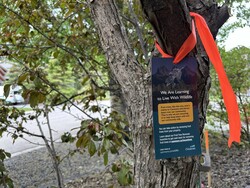
Current Action Spotlight
Removing Fruit Trees on Public Land
Bears don’t belong in our neighbourhoods. Bears accessing fruit trees in residential areas is one of the main reasons for a bear being relocated or killed.
We are leading by example by removing fruit trees on public land, including parks and road rights-of-ways. If tree removal is required adjacent to your property, we will inform you by mail.
How You Can Take Action
We all have a role to play as stewards of this place. Learn more about the actions you can take to help wildlife thrive.

Even the best dogs pose a danger to wildlife. They may surprise, harass, stress, injure, or even kill wildlife.
Off-leash dogs are one of the most common causes of wildlife attacks on people and pets. An off-leash dog may bring back an agitated wild animal (like a bear) towards you in pursuit of your dog. You, your dog, and/or other people, and the bear may be injured or killed.
What You Can Do
- Keep your dog on leash: It’s the law. If your dog is off leash outside of designated areas, you may be charged and face fines.
- In Canmore the fines for off-leash dogs are $250 for the first offence, $500 for the second, and $1,000 for third and subsequent. The fines are even stiffer for dogs harassing wildlife: $750 for the first offence, $1,500 for the second offence, and $2,500 for third and subsequent offences.
- Report off-leash dogs to Municipal Enforcement. Call 403.678.4244.
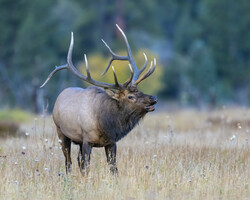
Give wildlife the space they need to survive and thrive. Whether you are exploring Canmore by foot, bike or vehicle, when you see wildlife, give them space for your safety and their survival.
What You Can Do
Help keep them wild by maintaining a minimum distance of:
- 3 bus lengths of space (30 metres) - deer, elk, sheep and moose
- 10 bus lengths of space (100 metres) - bears, wolves, cougars and coyotes
- Remember small animals like rodents and birds, need space too!
Never approach wildlife. Do not startle wildlife. If you make them move, you are too close.
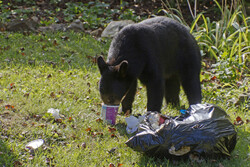
A wildlife attractant is any substance or item that draws wild animals to an area. Common wildlife attractants include:
- Food sources like pet food, birdseed, and household garbage
- Organic waste such as compost, fruit from trees, and pumpkins
- Scented items like barbecues and outdoor cooking utensils
In Canmore, people and wildlife share the Bow Valley. These attractants can draw hungry wildlife into our community, putting our safety – and theirs – at risk.
Attractants are especially dangerous because they can encourage animals to become habituated to human spaces, which increases the risk of conflicts and can result in harm to both people and wildlife.
What You Can Do
Do your part by properly managing attractants by securing garbage storage, cleaning up food and waste, and using bear-proof containers to keep wildlife wild and our community safe.
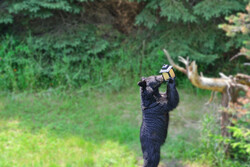
Bird feeders can attract hungry bears into neighbourhoods which puts our community at risk. Bears that access food could injure or kill people or pets and may need to be relocated or killed.
What You Can Do
- Prevent wildlife from accessing any food on your property, including garbage, bird feeders, and fruit trees.
- Consider not using a bird feeder. Birds have plenty of natural sources of food in this valley!
- Do not use bird feeders of any kind during bear season (April 1 to Nov. 30) - it's the law.
Failure to remove wildlife attractants can result in fines of $250 for the first offence, $500 for the second, and $1,000 for the third. If a bear is found eating from your feeder it can result in increased fines of $1,000 for the first offence, $5,000 for the second offence or $10,000 for the third offence.
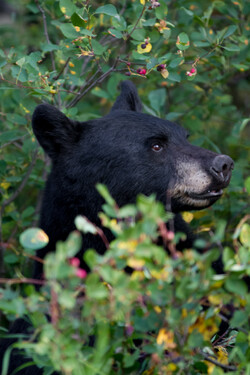
Berry bushes and fruit trees can attract bears into residential areas, putting wildlife and people at risk. Ornamental crab-apple, chokecherry, and mountain ash trees, as well as buffalo berry are common trees and bushes found in Canmore.
It is against the law in Canmore to let fruit or berries accumulate on trees, bushes, or the ground. You also can’t plant new fruit bearing trees or bushes in your yard.
What You Can Do
- Remove the fruit trees or bushes from your property. You can get cash back for removing fruit trees from your yard with our Fruit Tree Removal Incentive Program.
- If you can’t remove the tree, it is your responsibility to remove the fruit as soon as it begins to ripen and bring it indoors or properly dispose of it in a bear proof food waste bin, located throughout the community. The collected fruit will be composted.
- Before fruit grows, prune or remove fruit trees to prevent them from attracting wildlife.
- If fruit has already grown, remove fruit from the branches and dispose of it properly. Place fruit in a food waste bin and dispose of any branches separately at the Boulder Crescent Depot Scrub and Brush area located at 115 Boulder Cresent. Please note that we do not accept branches with fruit, as they attract wildlife.
- Bow Valley residents can borrow fruit-picking equipment from the Biosphere Institute for free. Contact resource@biosphereinstitute.org for details.
Failure to remove fruit or secure other wildlife attractants can result in fines of $250 for the first offence, $500 for the second, and $1,000 for the third. If a bear is found in your tree eating fruit it can result in increased fines of $1,000 for the first offence, $5,000 for the second offence or $10,000 for the third offence.
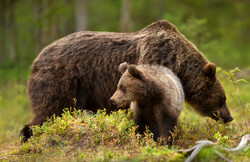
Canmore is bear country. Bear spray is a very effective way of deterring a bear or other wildlife at close range, and it can save your life.
Bear spray has also been shown to be effective at deterring other wildlife such as cougars, wolves, coyotes and elk.
What You Can Do
- Always carry bear spray, keep it accessible and know how to use it.
- Learn more about how to use bear spray and read the weekly bear report from WildSmart.

